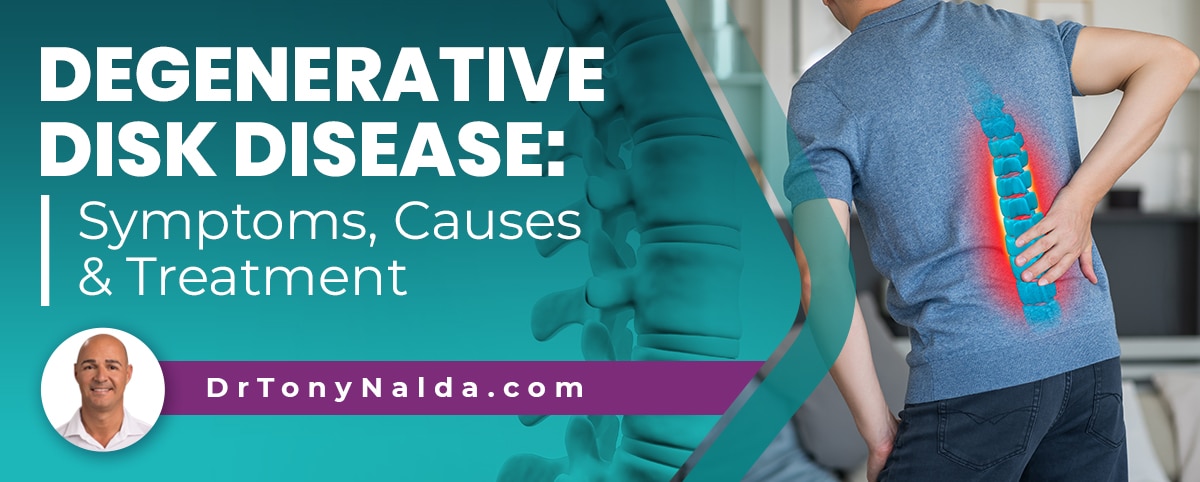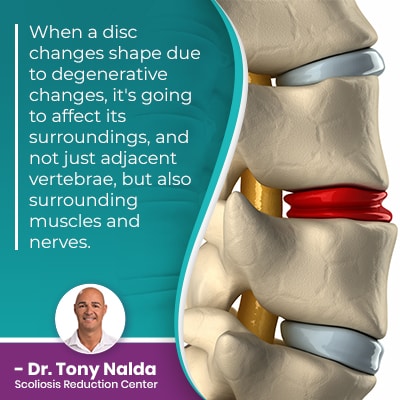Degenerative Disk Disease: Symptoms, Causes & Treatment

The spine consists of vertebral bodies stacked on top of one another in a straight and neutral alignment, and adjacent vertebrae are separated by an intervertebral disc that's key to maintaining spinal health, strength, flexibility, and function; in fact, degenerative disc disease is a contributing factor in the development of a number of spinal conditions/issues.
Degenerative disc disease treatment will depend on the cause of the disc degeneration; once the underlying cause of the disc degeneration is determined, treatment plans can be customized. Symptoms of disc degeneration can include back and nerve pain, muscle pain, and mobility issues.
The discs are key spinal structures, so let's start with some basic spinal anatomy, with a focus on the intervertebral discs.
Table of Contents
Spinal Anatomy
Spines are naturally curved because it makes them stronger, more flexible, and better able to handle mechanical stress incurred during movement.
The spine has three main spinal sections, and degenerative disc disease can develop in any one of them: the cervical spine (neck), thoracic spine (middle/upper back), and the lumbar spine (lower back).
Each spinal section consists of vertebrae stacked on top of one another in a straight and neutral alignment, and an intervertebral disc sits between adjacent vertebral bodies.
A healthy spine is one that has its natural curves and alignment in place, and healthy spinal discs facilitate that in a number of ways.
Intervertebral Discs
The spine's intervertebral discs consist of two main structures: a soft gel-like interior called a nucleus and a tough durable outer layer called the annulus.
The intervertebral discs cushion adjacent vertebrae so friction isn't generated during movement, act as the spine's shock absorbers, provide the spine with structure (adjacent vertebrae attach to the disc in between), and they combine forces to facilitate spinal flexibility and range of motion (ROM).
So the discs play many important roles in maintaining spinal health, and in addition to these many important roles, there is another reason the spinal discs are generally the first spinal structures to start to deteriorate; they are the largest structures in the body without their own vascular supply.
The discs not having their own vascular supply means there is no direct path in and out of the discs through which important nutrients and oxygen can pass to help rejuvenate and repair, and this is why disc damage can be difficult to reverse.
The discs are made largely of water, collagen fibers, and proteoglycans, and when we're born, the discs consist of approximately 80 percent water, but that fluid level tends to decrease with age, and if a disc experiences excessive fluid loss, this is known as disc desiccation and is part of degenerative disc disease.
Degenerative Disc Disease
When it comes to spinal degeneration, it's most often the spinal discs that are the first structures to feel the effects of deterioration.
When a disc becomes desiccated, it loses height, and this change in shape will affect the position of nearby vertebrae, and this can cause them to shift out of alignment with the rest of the spine, and a loss of the spine's healthy curves disrupts the biomechanics of the entire spine.
 When a disc changes shape due to degenerative changes, it's going to affect its surroundings, and not just adjacent vertebrae, but also surrounding muscles and nerves.
When a disc changes shape due to degenerative changes, it's going to affect its surroundings, and not just adjacent vertebrae, but also surrounding muscles and nerves.
A damaged disc can easily become a bulging and/or herniated discs, and this means even more changes to the shape and health of the discs and the affected disc's surroundings.
For example, if a disc's inner nucleus is pushing against its outer annulus, causing the disc to bulge outwards, it's taking up more space in the spine than it used to, and that space is being taken from somewhere, and often, that's space used by the spinal nerves to function optimally within.
The spinal column contains 31 pairs of spinal nerves with roots that branch off from the spine and into different areas of the body.
Common symptoms of degenerative disc disease can include back pain ranging from mild to severe pain, muscle spasms, pinched nerve, nerve damage, weak muscles in the upper thighs, sore leg muscles, difficulty maintaining proper posture, etc.
Degenerative disc disease is diagnosed in aging adults experiencing spinal degeneration, and while there is a certain amount of spinal degeneration to be expected with age, there are also additional factors.
Degenerative Disc Disease Causes
Everyone will experience some degree of spinal degeneration as they age, but not everyone will develop degenerative disc disease, and this is often due to the cumulative effect of certain lifestyle factors.
Carrying excess weight is the most unhealthy lifestyle factor for spinal health as it means straining the body's joints, including the spine.
In addition, obesity tends to couple with a sedentary lifestyle, and as the very design of the spine is based on movement, this is contrary to that; as the discs don't have their own vascular supply, increasing circulation through movement is the best way to rehydrate the discs and make nutrients and oxygen needed for disc repair more accessible through osmosis.
Losing weight can mean less pressure on the spine and its individual parts, and this can improve spinal health and function.
Chronic poor posture can also lead to spinal degeneration by exposing the spine and its surroundings to adverse spinal tension that, over time, can affect the position of certain vertebral bodies, and this affects the discs that sit in between.
People whose jobs involve repeatedly lifting heavy objects are also at higher risk for faster rates of spinal degeneration, particularly if the ergonomics of spine-friendly lifting aren't being practiced.
Other lifestyle factors that impact disc health include excessive consumption of alcohol and/or smoking as this contributes to disc desiccation.
When lifestyle issues such as carrying excess weight are addressed, it can relieve pressure on the spine and its discs, and this improves overall spinal health, strength, and function.
In addition to lifestyle factors, a spinal injury or trauma can lead to degenerative disc disease, as can the presence of certain spinal conditions like scoliosis and osteoporosis.
Degenerative Disc Disease Treatment
 When it comes to treating degenerative disc disease, the first step is determining its underlying cause, and while there are never treatment guarantees, when detected early, before a lot of progression has occurred, and treated proactively, a degree of disc regeneration is possible.
When it comes to treating degenerative disc disease, the first step is determining its underlying cause, and while there are never treatment guarantees, when detected early, before a lot of progression has occurred, and treated proactively, a degree of disc regeneration is possible.
However, it's important to understand that just as the process of disc degeneration takes place slowly over time, the process of reversing disc damage can be equally lengthy.
If the cause includes lifestyle factors, they can be addressed with guidance and physical therapy, and if the presence of a spinal injury or condition is the cause, the injury and/or spinal condition has to be treated first, as the disc degeneration is a symptom of a larger issue.
Here at the Scoliosis Reduction Center, I find that integrating a number of condition-specific treatment disciplines into treatment plans allows me to fully customize them around key patient/condition variables, and it also allows for treatment to be easily adjusted based on how the spine is responding.
I use chiropractic care to work towards addressing any areas of vertebral subluxation as this can mean taking pressure off an affected disc, and physical therapy and condition-specific stretches can help by increasing core strength so the spine is optimally supported/stabilized by its surrounding muscles, improving posture, and activating certain areas of the brain for enhanced brain-body communication.
Hot and cold therapy can also help; hot therapy can improve circulation and reduce muscle spasms and tension, and cold therapy can help reduce inflammation and provide short-term pain relief.
Conclusion
When it comes to quality of life, spinal health and function are key.
The spine doesn't just allow us to stand upright and practice good posture, it also protects important organs, allows us to move flexibly, and works in tandem with the brain to form the body's central nervous system (CNS).
As such an important structure of human anatomy, being proactive with spinal health by leading a spine-friendly lifestyle can have a number of benefits, including preventing/slowing spinal degeneration and preserving disc health and function.
Here at the Center, I've treated a wide range of spinal conditions, including degenerative disc disease, which is a contributing factor in the development of a number of spinal conditions such as degenerative scoliosis, osteoporosis, bone spurs, and spinal stenosis.
Once I determine the underlying cause of the disc degeneration, the goal is to work towards preventing further damage, preserving disc function, and improving the affected disc's health and the health of its surroundings.
When treated proactively and addressed before disc damage progresses, nonsurgical treatment can help improve disc health, prevent pain and other symptoms, and help avoid the need for spinal fusion and/or artificial disc replacement.
While pain medication and epidural steroid injections can help with short-term pain management, to alleviate pain long term, degenerative disk disease has to be treated proactively and its underlying cause has to be addressed.
Dr. Tony Nalda
DOCTOR OF CHIROPRACTIC
After receiving an undergraduate degree in psychology and his Doctorate of Chiropractic from Life University, Dr. Nalda settled in Celebration, Florida and proceeded to build one of Central Florida’s most successful chiropractic clinics.
His experience with patients suffering from scoliosis, and the confusion and frustration they faced, led him to seek a specialty in scoliosis care. In 2006 he completed his Intensive Care Certification from CLEAR Institute, a leading scoliosis educational and certification center.
About Dr. Tony Nalda
 Ready to explore scoliosis treatment? Contact Us Now
Ready to explore scoliosis treatment? Contact Us Now





